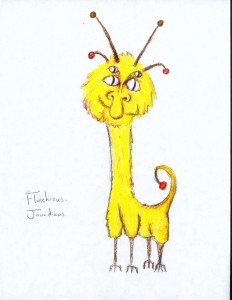The first thing I did after I put my two-year-old son to bed a couple weeks ago was draw an alien. I had been waiting to start my drawing since observing Jed Smith’s alien DNA activity earlier that day. For me, drawing the alien was everything. I’m guessing it was for many of his students as well.
Before beginning this cooperative activity with his students, Smith taught them the process for transcribing DNA (a series of A’s, G’s, C’s and T’s) into mRNA (a series of A’s, G’s, C’s and U’s), and translating mRNA into proteins. These proteins are determined by a sequence of amino acids, which in turn tell something about the genetic trait. In this case, the genetic traits included alien features—2 antennae or 4, 4 eyes or 8, blue skin or yellow.
Why It Worked
The process itself is easy to follow. It’s also one of those processes that is easy to forget a few minutes later. That’s why, for me, the alien was going to be everything:
1) Drawing the alien was my motivation. I like drawing, even if I’m not good at it. “Drawing science†and using my imagination was going to be fun.
2) Drawing was going to make it concrete. Tell me my alien has yellow fur? So what. Let me color his fur yellow? That I can see. And I like it.
3) I’m not going to forget this. It would be easy to forget that whole DNA RNwhatever, but it’s not hard to remember the process I used to discover how a bunch a letters turned into a hideous alien. I guarantee by EOC time I could do it again.
Doing this activity was a great reminder to me. I’ve always found it difficult to make time for activities like creating visual representations. The fact is, the biology SCOS doesn’t say anything about drawing an alien, and students definitely don’t use crayons on their EOC exams. The teacher must simply trust what they know about the brain, about memory, about multiple intelligences and allow their students the time to create visual representations of the knowledge, concepts and processes they learn—the time to draw aliens.
Collaboration
Although each student got to decode and draw his own alien, Smith’s students collaborated on this task by helping each other through the process. But collaboration on this assignment is two-fold. The initial collaboration occurred in the science department. Mr. Smith obtained this elaborate activity through other members of his department, who had discovered and expanded it several years ago. Now almost all of the biology teachers use it, maybe not in the exact same way, and definitely not on the same day, but they use it. This activity is evidence: collaboration is effective in the classroom and the staff room.

